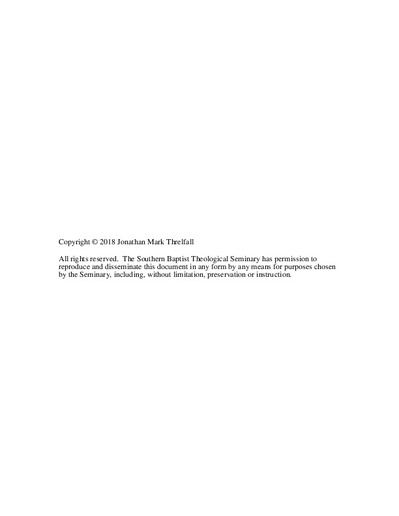| dc.contributor.advisor | Blount, Douglas K. | |
| dc.contributor.author | Threlfall, Jonathan Mark | |
| dc.date.accessioned | 2018-06-07T20:12:12Z | |
| dc.date.available | 2018-06-07T20:12:12Z | |
| dc.date.issued | 2018-06-07 | |
| dc.identifier.uri | http://hdl.handle.net/10392/5617 | |
| dc.description.abstract | Endeavoring to invigorate a Pascalian approach to Christian persuasion, this dissertation asks: How might the doctrine of the imago Dei strengthen Pascal’s anthropological argument? The central claim is that the doctrine of the imago Dei strengthens Pascal's anthropological argument by supplying greater detail to the explanation stage and accounts for more instances of humans’ paradoxical condition.
Chapter 1 demonstrates the need for this study. Even though Pascal’s method appears to be a formidable tool for Christian apologists in a postmodern culture, it has received surprisingly little attention and clarity in apologetic literature. Moreover, no efforts have been made to strengthen his anthropological argument by correlating it with insights from the doctrine of the imago Dei.
Chapter 2 reveals that the anthropological theme within Pascal’s Pensées may be properly understood as a three-stage abductive argument consisting of data (instances of humans’ paradoxical behavior), explanation (Christian anthropology), and elimination (other religions or worldviews fail to explain the human condition).
Chapter 3 surveys the history of interpretation of the doctrine of the imago Dei. Despite their many differences, interpreters generally agree that (1) imagedness means that humans are ontologically constituted for a relationship with God, but that (2) human sin conflicts with their God-oriented constitution.
Chapter 4 presents six propositions about imagedness. These propositions support the observation that imagedness and sinfulness conspire to render the human condition paradoxical: humans are self-opposing.
Chapter 5 applies this understanding of the imago Dei to the explanatory stage of Pascal’s anthropological argument, showing that the doctrine of the imago Dei provides a finer level of detail and explains more instances of humans’ paradoxical condition.
Chapter 6 shows that the Christiformic journeys of Augustine, C. S. Lewis, and Jonathan Edwards represent flesh-and-blood instances of Scripture’s portrait of Christiformic image-bearers. These instances supply evidence that the doctrine of the imago Dei plausibly explains the human condition. Thus, they also strengthen Pascal’s anthropological argument.
Chapter 7 explains two larger aims of this dissertation: to contribute toward a broader vision of Christian persuasion and to exemplify how the disciplines of apologetics and biblical theology can be powerful allies. | en_US |
| dc.subject.lcsh | Pascal, Blaise, 1623-1662 | en_US |
| dc.subject.lcsh | Image of God--History of doctrines | en_US |
| dc.subject.lcsh | Theological anthropology--Christianity | en_US |
| dc.title | The Imago Dei and Blaise Pascal's Abductive Anthropological Argument | en_US |
| dc.type | Electronic dissertation | en_US |
| dc.type | Text | en_US |
| dc.publisher.institution | Southern Baptist Theological Seminary | en_US |

